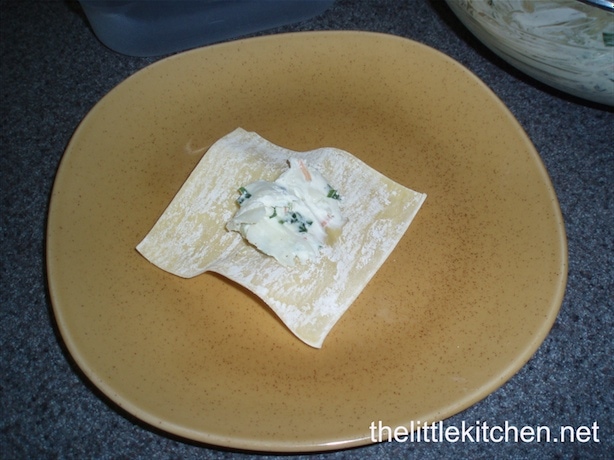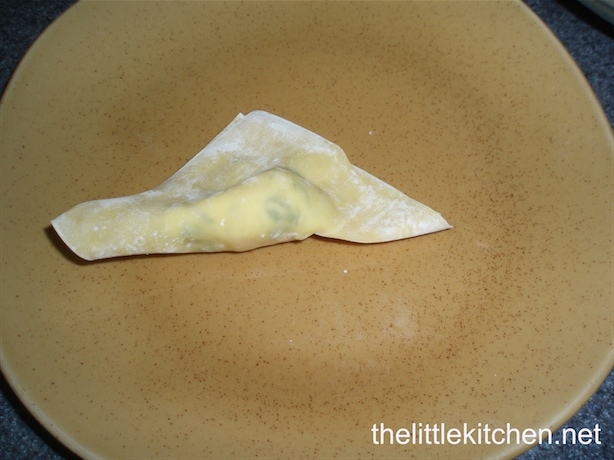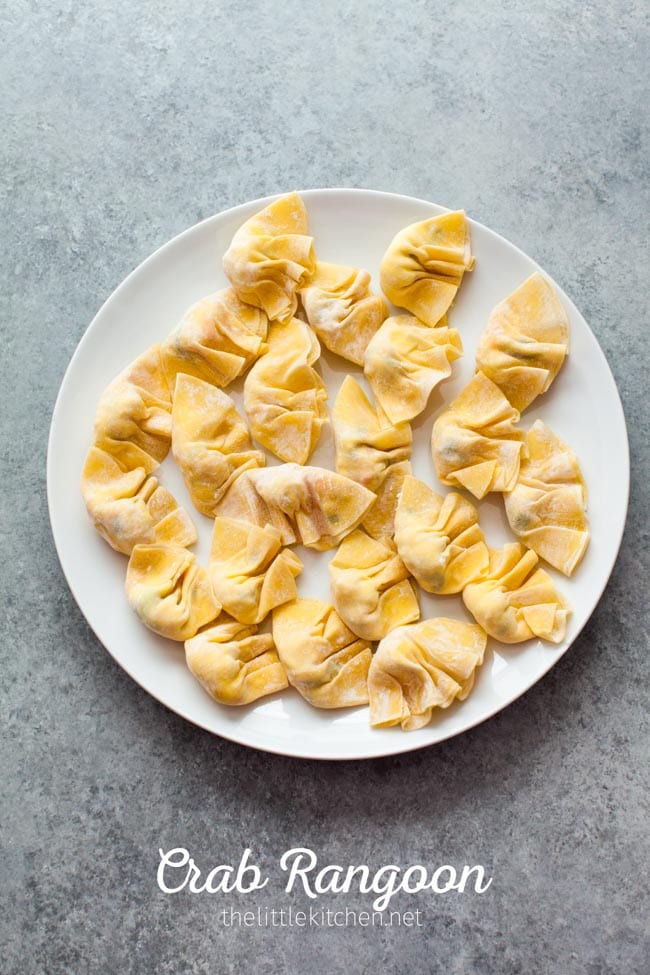Crab rangoon is a popular Chinese-American appetizer found on many restaurant menus. Also known as crab puffs or crab cheese wontons, this crispy deep-fried dumpling is stuffed with a creamy filling made of crab and cream cheese. While takeout crab rangoon is tasty it’s even better when you make it at home. With my easy recipe and folding techniques you’ll learn how to prepare the creamy crab filling and wonton wrappers for the perfect crab rangoon experience.
An Overview of Crab Rangoon
Crab rangoon consists of wonton wrappers stuffed with a creamy crab filling that usually contains a mixture of crab meat (or imitation crab), cream cheese, scallions, garlic, and seasoned with soy sauce. The stuffed wontons are sealed shut into a triangle, crescent, or rectangle shape before being deep-fried until golden brown and crispy.
The filling should be creamy but still contain good chunks of crab meat, The best crab rangoons have a balance of crab flavor paired with creaminess from the cheese, Too much cream cheese leads to greasy crab puffs that lack flavor High quality lump or imitation crab meat is key for great tasting crab rangoon
Crab rangoon is best when served warm right after frying so the crispy exterior contrasts the hot filling inside. It’s typically offered as an appetizer or side dish alongside main entrees at Asian restaurants and takeout places. The crab puffs are meant to be picked up with your fingers and dipped in sweet chili sauce or duck sauce before taking a crunchy bite.
Choosing the Crab Meat
The type of crab meat you use will impact flavor and texture. Here are some of the most common options:
-
Imitation crab: Also called surimi, this is made of pollock fish that has been blended and flavored to resemble crab. It’s cheaper than real crab and provides a mild sweet flavor. The texture can be a bit gummy.
-
Lump crab meat: Harvested from king crab, snow crab, and Dungeness crab. It consists of whole lumps of premium white crab meat. Provides delicious sweet crab flavor but costs more.
-
Backfin crab meat: Made up of smaller pieces and shards of white crab meat from the backfin area. More affordable but still offers good crab taste.
-
Claw crab meat: A mix of brownish meat from crab claws, legs, and body. Strongest in crab flavor but chewier texture.
For the best results, I recommend using lump crab meat. But backfin or imitation crab also works well and helps cut costs. Just avoid claw meat since the uneven texture may tear the wrappers.
Choosing the Wonton Wrappers
Look for thin, square wonton wrappers in the refrigerated section of the grocery store, often near the tofu. Wonton wrappers are usually made with flour, water, and eggs. For frying crab rangoon, it’s best to avoid brown rice or whole grain wrappers which can become too crispy and stiff when fried.
You want wrappers that are thin enough to make folding easy but still sturdy so they won’t break during filling and frying. Most wonton wrapper packages contain at least 50 wrappers so you’ll have plenty for crab puffs.
Prepping the Crab Rangoon Filling
The filling for crab rangoon comes together quickly in just 10 minutes. Follow this easy recipe:
Ingredients:
- 8 oz cream cheese, softened
- 6 oz crab meat, drained if canned
- 2 scallions, finely chopped
- 1 clove garlic, minced
- 1/2 tsp Worcestershire sauce
- 1/4 tsp soy sauce
- Black pepper to taste
Instructions:
-
In a bowl, beat together the cream cheese until smooth and creamy.
-
Mix in the crab meat, scallions, garlic, Worcestershire sauce, soy sauce, and black pepper. Stir until fully combined.
-
Refrigerate the filling for at least 30 minutes to firm it up. This makes it easier to fill the wontons.
-
Once chilled, scoop up about 1 tbsp of filling per wonton. Keep the remaining filling refrigerated as you work.
The additions of scallion, garlic, Worcestershire and soy sauce add lots of flavor depth to balance the richness of the cream cheese. Crab rangoon filling can also be made 1 day in advance and stored in the fridge until ready to use.
Filling and Forming the Wontons
Here are some easy methods to fill and shape crab rangoon:
-
To fill: Place 1-2 teaspoons of the chilled crab filling into the center of a wonton wrapper. Brush water around the outer edges of the wrapper to help seal it.
-
To fold into a triangle: Bring together two opposite corners so they overlap on top of the filling. Firmly press the edges to seal. For a crisper texture, spray the folded rangoon with cooking oil before frying.
-
To fold into a rectangle: Fold wrapper in half into a rectangle, sealing the edges. For a fun shape, tie the middle with a small scallion strip.
-
To pleat: Pleat and press the edges of the wrapper to form a cup or purse shape around the filling. Pinch corners if desired.
-
To seal: Dab your finger in egg wash (1 beaten egg + 1 tsp water) and brush it over the edges to help seal the wontons.
For parties, set up an assembly line so each person can fill and fold their own crab rangoon. Kids love getting involved with preparing the dumplings.
Frying Methods for Crispy Crab Rangoon
The two main methods for frying crab rangoon are:
-
Deep fry: Heat 2-3 inches of oil to 350°F in a pot. Deep fry 6-8 rangoon at a time for 1-2 minutes until golden brown. Drain on a paper towel-lined plate.
-
Pan fry: Add 1/2 inch oil to a skillet and heat over medium high heat. Pan fry the crab puffs in batches for 2-3 minutes per side until crispy. Turn carefully using tongs or chopsticks.
Deep frying makes the wontons extra crispy, but pan frying is easier for small batches. Use neutral vegetable, peanut, or canola oil which can withstand high heat.
Let the oil return to temperature between batches. Frying too many at once lowers the temp and makes them oil-logged.
Cooking Tips for Perfect Crab Rangoon
Follow these simple tips for the best homemade crab rangoon:
-
Don’t overfill: Too much filling causes leaks in the wrappers. Stick to 1-2 teaspoons per wonton.
-
Use a slotted spoon: To remove rangoon from oil so excess oil can drip off back into the pot.
-
Work in batches: Frying 6-8 puffs at a time helps maintain oil temperature.
-
Prevent sticking: Fold wontons loosely so filling has room to expand without tearing wrappers.
-
Blot oil: Drain fried crab puffs on paper towels to soak up excess grease for a crisper texture.
-
Keep them warm: Transfer cooked crab rangoons to a plate lined with a paper towel and keep warm in a 175°F oven if needed.
-
Freeze extras: Unfried, filled wontons can be frozen on a baking sheet then stored in freezer bags. Fry frozen rangoon straight from freezer.
Serving Suggestions for Crab Rangoon
Crab rangoon deserve more than just duck or sweet & sour sauce for dipping. Expand your horizons with these fun serving ideas:
-
Lettuce wraps: Serve crab puffs nested in butter lettuce cups for a low carb option.
-
Waffle cones: Stuff wontons into mini waffle cones for a whimsical passed appetizer.
-
Bahn mi: Layer crab rangoon into a Vietnamese sandwich with pickled veggies and spicy mayo.
-
Buddha bowl: Add crispy crab puffs to a grain bowl with edamame, carrots, sprouts and ginger dressing.
-
Nachos: Top nachos with fried crab rangoons, avocado, mango salsa and cilantro.
However you choose to serve them, crab rangoons are sure to be a major crowd pleaser. The crispy, savory dumplings pair well with both Asian-inspired dishes and American classics. Now that you know how quick and simple it is to prepare them at home, this recipe will become a go-to appetizer for entertaining or nights when you crave Chinese takeout flavors.

What is crab rangoon?
Crab rangoon is a fried appetizer served at American Chinese restaurants across the United States. But did you know they arent Southeast Asian or Chinese? Crab rangoon are actually an American invention!
The filling of crab rangoon is cream cheese, imitation crab meat and green onions. Some restaurants add garlic or other spices as well.

- 1 package of square or round wonton wrappers
- 8-ounce package imitation crab
- 2 (8-ounce) packages cream cheese
- 5-6 green onions
- salt and pepper
- vegetable or grape seed oil
How to fold crab rangoon
Its really easy to fold them. I show you how in the photos below. First you want to make sure to cover your wonton wrappers with a damp paper towel that way they dont dry out.
I usually do this with both of my hands but Im showing you below on a plate what each step looks like.

Take about a teaspoon of the crab-cream cheese filling and spread it onto the middle of a wonton wrapper with a spoon.

Then, fold it in half to make a triangle.

Then, pinch with your fingers near the filling and fold the side corners in (as pictured above).

It actually comes together really fast and youll have a bunch of these wonderful crab rangoon!
How to Make: Easy Homemade Crab Rangoon Recipe That Tastes Better Than Takeout
FAQ
What is crab rangoon filling made of?
Crab Rangoon filling typically consists of a mixture of cream cheese, crab meat (often imitation crab meat), and seasonings like green onions, garlic, soy sauce, and Worcestershire sauce.
What are some common mistakes when making crab rangoon?
If there is too much filling, the rangoon can explode in the fryer, and if there is too little, all you get is a big bite of fried wonton wrapper. It’s much better when every bite can have filling sandwiched between the crispy-and-slightly-chewy wrappers.
Does Crab Rangoon have any real crab in it?
Since most crab rangoons don’t contain real crab meat, you shouldn’t order it. A crab whose appearance is imitation of one from a real crab. In many cases, there’s only one main ingredient:’s urimi or ‘krab’.
What is the difference between fried wonton and Crab Rangoon?
Typically fried wontons are filled with a mixture of onion and cream cheese. A crab rangoon is also stuffed with cream cheese, but adds in some delicious crab meat to really amp up the flavor! Need more delicious appetizer recipes?
Is the Crab Rangoon a native Chinese recipe?
The Chinese have been here since the 1800s and if dishes were created by Asians in America I think they are totally authentic. Dishes like orange chicken, California roll, spicy tuna and crab rangoon have now made their way back to the Asian countries from which their native creators originated.
